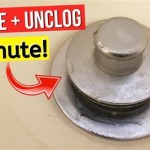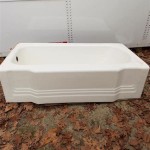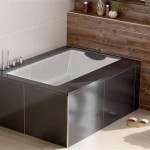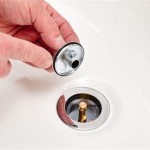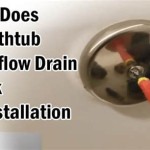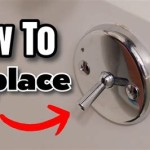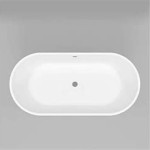How To Drain a Bathtub Clogged With Hairspray
A slow-draining or completely clogged bathtub is a common household nuisance. While various substances can contribute to this problem, hairspray is a frequent culprit. The sticky nature of hairspray allows it to bind with hair and other debris, forming a stubborn mass that obstructs the drain. This article details a comprehensive approach to clearing a bathtub drain clogged with hairspray, outlining various methods from simple solutions to more involved techniques.
Understanding the Problem: Hairspray's Role in Drain Clogs
Hairspray is designed to provide a strong hold and often contains polymers, resins, and solvents. These ingredients, responsible for the spray's adhesive properties, become problematic when they enter the drainage system. When hairspray washes down the drain, it coats the pipes' interior surfaces. Hair, soap scum, and other organic matter readily adhere to this coating, creating a sticky, accumulating blockage. Over time, this accumulation can severely restrict water flow, leading to a slow-draining or completely clogged bathtub.
The problem is exacerbated by the fact that hairspray is often used in or near the bathroom. Overspray can easily land in the bathtub or shower alcove, eventually washing down the drain. The frequency of hairspray usage directly correlates with the likelihood of drain clogs. Therefore, understanding the composition and properties of hairspray is essential to developing effective solutions for resolving related drain issues.
Furthermore, the problem is often compounded by the presence of hard water. The minerals in hard water can react with soap and create soap scum, which further adheres to the hairspray coating within the pipes, accelerating the clogging process. Therefore, the type of water in a household can also influence the severity and frequency of drain clogs caused by hairspray.
Initial Steps: Assessing the Clog and Gathering Tools
Before initiating any drain-clearing method, it is crucial to accurately assess the severity of the clog. Observe the bathtub's drainage rate. If the water drains very slowly but does drain eventually, the clog is likely partial and may be addressed with milder techniques. If the water remains stagnant, the clog is more severe and requires a more aggressive approach. Avoid using the bathtub until the clog is resolved to prevent further accumulation of debris.
Next, gather the necessary tools. A basic toolkit should include: rubber gloves (to protect hands), a plunger (specifically designed for bathtubs with overflow drains), a drain snake (also known as a plumbing snake or auger), a screwdriver (to remove drain covers), a bucket (to catch debris), and baking soda and vinegar (for a natural drain-cleaning solution). A wet/dry vacuum can also be useful for removing standing water and debris from the drain. Having all these tools readily available will streamline the process and increase the likelihood of success.
Safety precautions are also paramount. Always wear rubber gloves to protect skin from harsh chemicals and bacteria present in the drain. Ensure proper ventilation in the bathroom, especially when using chemical drain cleaners, which can release harmful fumes. If using a drain snake, exercise caution to avoid damaging the pipes. When working with electrical tools, such as a wet/dry vacuum, ensure the area is dry to prevent electric shock. Prioritizing safety throughout the process will ensure a successful and injury-free drain-clearing experience.
Method 1: Plunging the Drain
Plunging is often the first and simplest method to attempt. It works by creating pressure to dislodge the clog. The effectiveness of plunging depends on creating a tight seal around the drain opening. Start by removing the drain stopper. If it's a pop-up stopper, it might require unscrewing or lifting it out. For other types of stoppers, consult the manufacturer's instructions for removal. Clean any visible debris from the stopper to prevent it from re-entering the drain.
Next, ensure there is enough water in the bathtub to cover the plunger cup. If there isn't enough water, add some from the faucet. The water acts as a medium to transfer the pressure created by the plunger to the clog. It is crucial to have a sufficient water level to prevent air from escaping around the plunger cup.
Properly position the plunger over the drain opening. Ensure the cup completely covers the drain and creates a tight seal. For bathtubs with an overflow drain, it is essential to seal the overflow drain opening with a wet cloth or duct tape. This prevents air from escaping through the overflow drain, allowing the plunger to generate maximum pressure at the drain opening. Then, start plunging vigorously up and down, maintaining the seal. Continue plunging for several minutes, periodically checking to see if the water begins to drain. If the water drains, run hot water down the drain for several minutes to flush out any remaining debris. If the drain remains clogged, proceed to the next method.
Method 2: Baking Soda and Vinegar Solution
Baking soda and vinegar create a chemical reaction that can help dissolve organic matter and loosen clogs. This method is a natural alternative to harsh chemical drain cleaners and is generally safer for both the plumbing and the environment. First, pour one cup of baking soda down the drain. It may be beneficial to use a funnel to ensure all the baking soda enters the drain opening. Baking soda will act as a base to react with the acid in the vinegar.
Next, slowly pour one cup of vinegar down the drain after the baking soda. The mixture will begin to fizz and bubble. This reaction is the result of the baking soda and vinegar combining to produce carbon dioxide gas, which helps to break down the clog. Allow the mixture to sit in the drain for at least 30 minutes, or ideally overnight. This allows the reaction to thoroughly dissolve the hairspray buildup and other debris.
After the waiting period, flush the drain with hot water. The hot water will help to wash away the dissolved debris and clear the drain. Run the hot water for several minutes to ensure all the loosened material is flushed out of the pipes. If the drain is still slow, repeat the process. It may take several applications of the baking soda and vinegar solution to completely clear the clog, especially if it is a severe one. This method is particularly effective for dissolving hairspray residue as it is less likely to damage pipes than harsh chemical alternatives.
Method 3: Using a Drain Snake (Plumbing Auger)
A drain snake, or plumbing auger, is a flexible tool specifically designed to physically break up and remove clogs from drains. It is more effective than plunging or baking soda and vinegar when dealing with stubborn or deeply lodged obstructions. To use a drain snake effectively, start by removing the drain stopper. If necessary, dismantle the drain cover using a screwdriver. This provides direct access to the drainpipe.
Carefully insert the drain snake into the drain opening. As the snake progresses, rotate the handle to help it navigate through the pipes and around bends. The rotation allows the snake to grab onto and break up the clog. Continue feeding the snake into the drain until resistance is felt, indicating that it has reached the clog. Once resistance is encountered, continue rotating the handle to break up or grab onto the obstruction.
After the snake has engaged the clog, carefully pull it back out of the drain. The snake may bring back a mass of hair, hairspray residue, and other debris. Clean the snake thoroughly after each extraction to prevent the debris from re-entering the drain. Repeat this process until the snake comes out clean, indicating that the clog has been effectively removed. After removing the clog, run hot water down the drain for several minutes to flush out any remaining debris. A drain snake is a powerful tool for removing physical obstructions, but it is essential to use it carefully to avoid damaging the pipes. Avoid forcing the snake if it encounters excessive resistance, and consider consulting a professional plumber if the clog persists.
Method 4: Wet/Dry Vacuum Technique
A wet/dry vacuum cleaner can be a useful tool for removing obstructions from a bathtub drain, particularly after other methods have loosened the clog. This technique involves using the vacuum to create suction to draw the clog out of the drainpipe. First, remove the drain stopper and any visible debris around the drain opening. Seal the overflow drain with a wet cloth or duct tape to maximize suction at the main drain.
If using a standard vacuum cleaner attachment, it's best to use one that creates a good seal around the drain opening. However, specialty wet/dry vacuum drain attachments are available that are specifically designed for this purpose, often offering a more secure and effective seal. These specialty attachments are designed to fit snugly into the drain without damaging the pipe.
Turn on the wet/dry vacuum and position the hose over the drain opening, ensuring a tight seal. Operate the vacuum in short bursts to avoid overheating the motor and to prevent water from damaging the vacuum. Check the vacuum hose and canister periodically for any debris that has been extracted from the drain. Continue this process until no more debris is being pulled out and the drain flows freely. This method is particularly effective for removing loose pieces of hair and hairspray residue. After completing the vacuuming process, flush the drain with hot water to ensure that any remaining debris is flushed out. The wet/dry vacuum technique is a practical way to remove debris from the drain without resorting to harsh chemicals or complex plumbing tools.
Preventative Measures: Reducing Hairspray Drain Clogs
Preventing drain clogs is always more efficient than resolving them. Several preventative measures can significantly reduce the likelihood of hairspray-related drain problems. One simple step is to avoid spraying hairspray directly over the bathtub or shower area. Use hairspray in a well-ventilated room, away from the bathroom, to minimize overspray and reduce the amount of hairspray that eventually ends up in the drain.
Another helpful measure is to install a drain strainer or hair catcher in the bathtub drain. These inexpensive devices effectively trap hair and other debris before they enter the drainpipe. Regularly clean the strainer to remove accumulated hair and residue. This simple maintenance task can significantly reduce the build-up of clogs over time.
Regularly flushing the drain with hot water can also help prevent clogs. Periodically, pour hot water down the drain for several minutes to help dissolve any accumulated hairspray residue and prevent it from hardening. This practice is particularly useful after using hairspray or taking a shower. Additionally, consider using a monthly drain cleaner, either a natural solution like baking soda and vinegar or a commercial drain cleaner, as a preventative measure to keep the pipes clear. By implementing these strategies, homeowners can significantly minimize the occurrence of hairspray-related drain clogs and maintain a smoothly functioning plumbing system.

How To Unclog Bathtub Drain Pipes Save 200 In Two Minutes

How To Take Hair Out Of Bathtub With Drain Cleaner Tiktok

Reposting This Because Its So Important Also Is From Before I Started Calling Myself Yhe Trans Handy Ma Am Singlemom Anexity Nuerodivergent

How To Unclog Bathtub Drain Pipes Save 200 In Two Minutes

The 3 Step Plumbers Trick To Keep Your Drains Clear

Replying To Cozy And Cray Jetted Tub Cleaning Methods I Will Thoroughly Clean The Jets If Customer Requests In Previous Needed Repairs Were Disconnected Because Of A

How To Unclog Bathtub Drain Pipes Save 200 In Two Minutes

The 3 Step Plumbers Trick To Keep Your Drains Clear

The Crossbars In A Bathtub Drain Are There To Help Install Tiktok

The 3 Step Plumbers Trick To Keep Your Drains Clear


